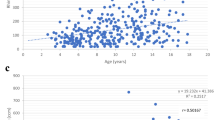Abstract
Nasal obstruction is a common symptom. Rhinomanometry is a tool to objectively assess the nasal airway. A prospective study was undertaken to assess the nasal airflow and nasal resistance in 25 patients of deviated nasal septum undergoing septoplasty using rhinomanometry preoperatively and postoperatively. Rhinomanometric improvement in nasal airflow and decreased nasal resistance were found in 88% patients after surgery.
Similar content being viewed by others
References
Beeson WH (1987) The nasal septum. Otolaryngol Clin N Am 20:743–767
Kasperbauer JL, Kern EB (1987) Nasal valve physiology: implicates in nasal surgery. Otolaryngol Clin N Am 20:699–701
Huygen PLM (1992) Rhinomanometric detection rate of rhinoscopically assessed septal deviation. Rhinology 30: 177–179
Broms P, Johnson B, Malm L (1982) Rhinomanometry IV. A pre and postoperative evaluation in functional septoplasty. Acta Otolaryngol 94:523–529
Gordon A, Fraes, McCaffrey TV Kern E (1989) Pallanch. Rhinomaometry for preoperative and postoperative assessment of nasal obstruction. Otolaryngol Head Neck Surg 101: 20–26
Pallanch JF (1985) Normal nasal resistance. Otolaryngol Head Neck Surg 93:778–782
Cole P (1988) Toronto rhinomanometry, field and clinical studies. J Otolaryngol 17:335–337
Sipila JI (1992) Rhinomanometry before septoplasty: an approach to clinical material with diverse nasal symptoms. Am J Rhinol 6:17–22
Holmstrom M, Kumlien J (1988) A clinical follow-up of septal surgery with special attention to the value of preoperative rhinomanometric examination in the decision concerning operation. Clin Otolaryngol 13:115–120
Piccini A, Biagini C, Sensini I (1991) Nasal dimorphism and respiratory dysfunction, preoperative selection of patients and follow up using computerized rhinomanometry. Acta Otorhinolaryngol Ital 11(2):143–149
Author information
Authors and Affiliations
Corresponding author
Rights and permissions
About this article
Cite this article
Gulati, S.P., Sachdeva, O.P., Wadhera, R. et al. Role of rhinomanometry to assess nasal airflow and resistance in patients undergoing septoplasty. Indian J Otolaryngol Head Neck S 60, 133–136 (2008). https://doi.org/10.1007/s12070-007-0119-x
Published:
Issue Date:
DOI: https://doi.org/10.1007/s12070-007-0119-x




